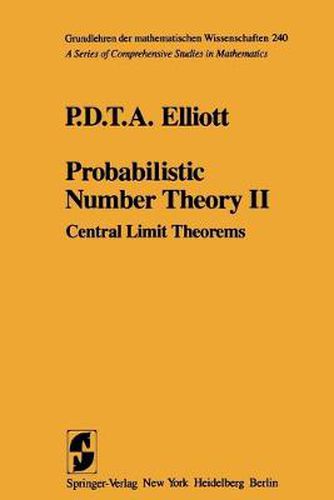Readings Newsletter
Become a Readings Member to make your shopping experience even easier.
Sign in or sign up for free!
You’re not far away from qualifying for FREE standard shipping within Australia
You’ve qualified for FREE standard shipping within Australia
The cart is loading…






This title is printed to order. This book may have been self-published. If so, we cannot guarantee the quality of the content. In the main most books will have gone through the editing process however some may not. We therefore suggest that you be aware of this before ordering this book. If in doubt check either the author or publisher’s details as we are unable to accept any returns unless they are faulty. Please contact us if you have any questions.
In this volume we study the value distribution of arithmetic functions, allowing unbounded renormalisations. The methods involve a synthesis of Probability and Number Theory; sums of independent infinitesimal random variables playing an important role. A central problem is to decide when an additive arithmetic function fin) admits a renormalisation by real functions a(x) and {3(x) > 0 so that asx ~ 00 the frequencies vx(n;f (n) - a(x) :s;; z {3 (x) ) converge weakly; (see Notation). In contrast to volume one we allow {3(x) to become unbounded with x. In particular, we investigate to what extent one can simulate the behaviour of additive arithmetic functions by that of sums of suit ably defined independent random variables. This fruiful point of view was intro duced in a 1939 paper of Erdos and Kac. We obtain their (now classical) result in Chapter 12. Subsequent methods involve both Fourier analysis on the line, and the appli cation of Dirichlet series. Many additional topics are considered. We mention only: a problem of Hardy and Ramanujan; local properties of additive arithmetic functions; the rate of convergence of certain arithmetic frequencies to the normal law; the arithmetic simulation of all stable laws. As in Volume I the historical background of various results is discussed, forming an integral part of the text. In Chapters 12 and 19 these considerations are quite extensive, and an author often speaks for himself.
$9.00 standard shipping within Australia
FREE standard shipping within Australia for orders over $100.00
Express & International shipping calculated at checkout
This title is printed to order. This book may have been self-published. If so, we cannot guarantee the quality of the content. In the main most books will have gone through the editing process however some may not. We therefore suggest that you be aware of this before ordering this book. If in doubt check either the author or publisher’s details as we are unable to accept any returns unless they are faulty. Please contact us if you have any questions.
In this volume we study the value distribution of arithmetic functions, allowing unbounded renormalisations. The methods involve a synthesis of Probability and Number Theory; sums of independent infinitesimal random variables playing an important role. A central problem is to decide when an additive arithmetic function fin) admits a renormalisation by real functions a(x) and {3(x) > 0 so that asx ~ 00 the frequencies vx(n;f (n) - a(x) :s;; z {3 (x) ) converge weakly; (see Notation). In contrast to volume one we allow {3(x) to become unbounded with x. In particular, we investigate to what extent one can simulate the behaviour of additive arithmetic functions by that of sums of suit ably defined independent random variables. This fruiful point of view was intro duced in a 1939 paper of Erdos and Kac. We obtain their (now classical) result in Chapter 12. Subsequent methods involve both Fourier analysis on the line, and the appli cation of Dirichlet series. Many additional topics are considered. We mention only: a problem of Hardy and Ramanujan; local properties of additive arithmetic functions; the rate of convergence of certain arithmetic frequencies to the normal law; the arithmetic simulation of all stable laws. As in Volume I the historical background of various results is discussed, forming an integral part of the text. In Chapters 12 and 19 these considerations are quite extensive, and an author often speaks for himself.